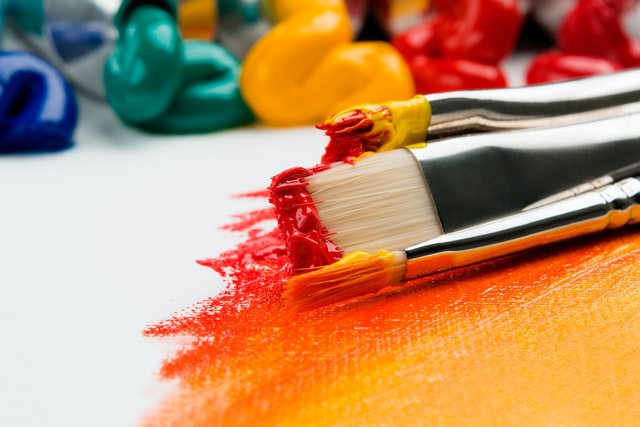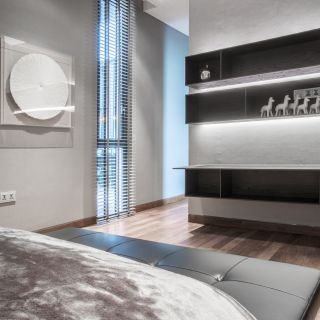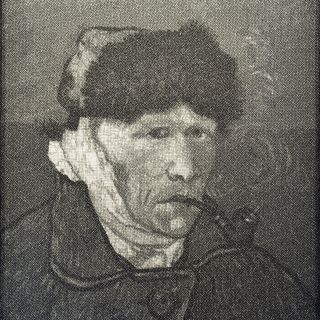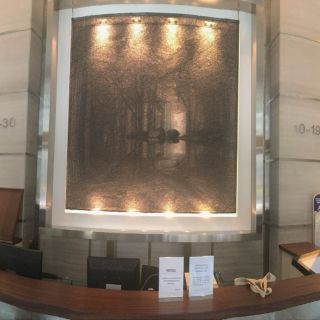Lee Ju Youn was born in South Korea and received a B.F.A. in 2006 and M.F.A. from the Department of Fiber Arts at Ewha Womans University in 2013. She has held solo exhibitions such as 'Sedimentation' at E-Land Space (Seoul) in 2015 and 'Stitch Drawing' at Gana Art Space (Seoul) in 2014. She has also taken part in group exhibitions featuring young artists such as the 2013 'Young Artists' exhibition in Pyunghwa Gallery, Seoul.
Biography 
Biography
Lee Ju Youn was born in South Korea and received a B.F.A. in 2006 and M.F.A. from the Department of Fiber Arts at Ewha Womans University in 2013. She has held solo exhibitions such as 'Sedimentation' at E-Land Space (Seoul) in 2015 and 'Stitch Drawing' at Gana Art Space (Seoul) in 2014. She has also taken part in group exhibitions featuring young artists such as the 2013 'Young Artists' exhibition in Pyunghwa Gallery, Seoul.
The artist identifies strongly with the words of Meyer Schapiro - a prominent art historian and critic who was originally from Lithuania and spent most of his life in New York City. Based on his writings and lectures, she started drawing her surroundings in order to discover factors which could represent herself. By drawing objects which she encountered in her daily life, it helped to shape who she was as an individual. Drawing allows her to capture moments of her life which tend to be fleeting and temporary.
Her recent works are mainly about books and books drew her attention most of the time that she was drawing. Books have a multiplicity of meanings, however, to her they represent goals and tasks to complete. There were books that were continuously piling up in the corners of her house and studio which had been neither read nor thrown away. At certain moments, she identified with certain books and thus set out to make them the theme of her latest series. Having studied Fiber Arts, she used the material of string as it was most familiar to her.
The artist identifies strongly with the words of Meyer Schapiro - a prominent art historian and critic who was originally from Lithuania and spent most of his life in New York City. Based on his writings and lectures, she started drawing her surroundings in order to discover factors which could represent herself. By drawing objects which she encountered in her daily life, it helped to shape who she was as an individual. Drawing allows her to capture moments of her life which tend to be fleeting and temporary.
Her recent works are mainly about books and books drew her attention most of the time that she was drawing. Books have a multiplicity of meanings, however, to her they represent goals and tasks to complete. There were books that were continuously piling up in the corners of her house and studio which had been neither read nor thrown away. At certain moments, she identified with certain books and thus set out to make them the theme of her latest series. Having studied Fiber Arts, she used the material of string as it was most familiar to her.
Exhibitions 
Exhibitions
Solo Exhibitions
2015: ‘Sedimentation,’ E-Land Space, Seoul
2014: ‘Stitch Drawing,’ Gana Art Space, Seoul.
2013: ‘The Stitch,’ Gallery DOS, Seoul. ‘The Stitch,’
Gana Art Space, Seoul.
Group Exhibitions
2015: ‘Voice of Korean Art,’ Ode to Art Gallery, Singapore
‘2015 Young Artist,’ Bank of Korea Gallery, Seoul.
‘Artex Moda’, Kyngpook National University Art Museum, Daegu.
2014: ‘Beautiful Container,’ Gana Art Space, Seoul.
‘Stitch Drawing,’ Gana Art Space, Seoul.
‘Steel Life - Lee Ju-Youn and Kim Taek-Gi,’ Lotte Gallery Jamsil, Seoul.
2013: ‘2013 - Young Artists,’ Pyunghwa Gallery, Seoul.
2006: ‘Ewha Fiber Art Exhibition,’ Seoul.
2015: ‘Sedimentation,’ E-Land Space, Seoul
2014: ‘Stitch Drawing,’ Gana Art Space, Seoul.
2013: ‘The Stitch,’ Gallery DOS, Seoul. ‘The Stitch,’
Gana Art Space, Seoul.
Group Exhibitions
2015: ‘Voice of Korean Art,’ Ode to Art Gallery, Singapore
‘2015 Young Artist,’ Bank of Korea Gallery, Seoul.
‘Artex Moda’, Kyngpook National University Art Museum, Daegu.
2014: ‘Beautiful Container,’ Gana Art Space, Seoul.
‘Stitch Drawing,’ Gana Art Space, Seoul.
‘Steel Life - Lee Ju-Youn and Kim Taek-Gi,’ Lotte Gallery Jamsil, Seoul.
2013: ‘2013 - Young Artists,’ Pyunghwa Gallery, Seoul.
2006: ‘Ewha Fiber Art Exhibition,’ Seoul.
Critique 
Critique
A Way of
Talking with Things - Lee Juyoun’s Stitch Drawing
by Ko Kyongok, Chief Curator, E-Land Foundation for Arts & Culture
Lee Juyoun’s work is a sort of drawing that creates forms with repetitive movements of black lines. The black lines are the vestiges of a sewing machine and thread. A dynamic scene is rendered when thread meets mechanical drawing and delicate hand movement is added. Her work can thus be described as being “drawn by stitching,” not by applying paints to a flat surface as with painting. This stitch drawing is the work of fashioning images with thread on a plane. It has the propensity of tactile two-dimensional work due to the thread left outside of the plane.
In a classical sense, the term ‘drawing’ refers to a pictorial expression with lines, not colors. Although drawing was used in the conception of work as a preliminary step for painting, drawing itself is considered an art form in contemporary art. Such an art form refers to spontaneous movements of the artist’s hand. Contemporary art tends to put more stress on the process of completing a work of art, the artist’s intent and inner conceptions than the completed work itself. In this sense, Lee’s work can be seen as an expansion of the concept of drawing to imbue it with modern meaning.
Lee’s stitch drawing was completed using black thread and a sewing machine. She mainly used synthetic fabrics such as urethane and polyethylene resin she crafted, at times, she also stitched the canvas cloth by hand. The synthetic textiles she used feel both vinyl-like and glossy simultaneously. Her work emits a sense of drawing while displaying the work of stitching and unstitching with thread and needle. Lee portrays books through repetitive stitches. The books she uses talk about themes that represent herself and she thus discovers some vestiges of herself in a pile of books. Her drawings look like chaekgado - a traditional folk painting genre featuring books and scholar’s paraphernalia.
What does her representation of books showcase about the artist? Books have been used as attractive subject matter to symbolize a treasure trove of knowledge and accumulation of time. There are parallels between reading and an artist’s creations in that one enjoys solitude and creation and, with books, can experience the space of imagination. Artists and books have been frequently addressed themes since the times of classical painting. Lee builds her own world with such books, trying to have a clandestine talk with things or objects. In the artist’s eyes, the book is an object of attachment and a motif of creation, offering her consolation.
Despite using a sewing machine, her work requires a lot of time and the repetitive movements are labor-intensive. Through this hard labor she generates double images, a drawing upon a drawing. The artist also ruminates about herself through the act of stitching, looking back on her life. Lee fully enjoys the pleasure of immersion while concentrating on artistic creation. Her attitude towards artistic work and creation resembles that of traditional Eastern art which used it as a tool for self-discipline. If we consider that Lee creates images with a modern medium and her art can be used as a means for self-discipline, we can see her stitch drawing from more multifarious perspectives.
by Ko Kyongok, Chief Curator, E-Land Foundation for Arts & Culture
Lee Juyoun’s work is a sort of drawing that creates forms with repetitive movements of black lines. The black lines are the vestiges of a sewing machine and thread. A dynamic scene is rendered when thread meets mechanical drawing and delicate hand movement is added. Her work can thus be described as being “drawn by stitching,” not by applying paints to a flat surface as with painting. This stitch drawing is the work of fashioning images with thread on a plane. It has the propensity of tactile two-dimensional work due to the thread left outside of the plane.
In a classical sense, the term ‘drawing’ refers to a pictorial expression with lines, not colors. Although drawing was used in the conception of work as a preliminary step for painting, drawing itself is considered an art form in contemporary art. Such an art form refers to spontaneous movements of the artist’s hand. Contemporary art tends to put more stress on the process of completing a work of art, the artist’s intent and inner conceptions than the completed work itself. In this sense, Lee’s work can be seen as an expansion of the concept of drawing to imbue it with modern meaning.
Lee’s stitch drawing was completed using black thread and a sewing machine. She mainly used synthetic fabrics such as urethane and polyethylene resin she crafted, at times, she also stitched the canvas cloth by hand. The synthetic textiles she used feel both vinyl-like and glossy simultaneously. Her work emits a sense of drawing while displaying the work of stitching and unstitching with thread and needle. Lee portrays books through repetitive stitches. The books she uses talk about themes that represent herself and she thus discovers some vestiges of herself in a pile of books. Her drawings look like chaekgado - a traditional folk painting genre featuring books and scholar’s paraphernalia.
What does her representation of books showcase about the artist? Books have been used as attractive subject matter to symbolize a treasure trove of knowledge and accumulation of time. There are parallels between reading and an artist’s creations in that one enjoys solitude and creation and, with books, can experience the space of imagination. Artists and books have been frequently addressed themes since the times of classical painting. Lee builds her own world with such books, trying to have a clandestine talk with things or objects. In the artist’s eyes, the book is an object of attachment and a motif of creation, offering her consolation.
Despite using a sewing machine, her work requires a lot of time and the repetitive movements are labor-intensive. Through this hard labor she generates double images, a drawing upon a drawing. The artist also ruminates about herself through the act of stitching, looking back on her life. Lee fully enjoys the pleasure of immersion while concentrating on artistic creation. Her attitude towards artistic work and creation resembles that of traditional Eastern art which used it as a tool for self-discipline. If we consider that Lee creates images with a modern medium and her art can be used as a means for self-discipline, we can see her stitch drawing from more multifarious perspectives.

Stay connected.
Sign up to our newsletter for updates on new arrivals and exhibitions







